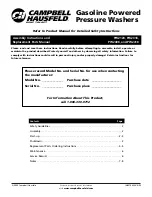
GB 9
TROUBLESHOOTING GUIDE
Your washing machine is equipped with automatic safety functions which detect and diagnose faults at an early
stage and allow you to react appropriately. These faults are frequently so minor that they can be removed within
a few minutes.
Problem
Causes - Solutions - Tips
Appliance does not start,
no indicator lamps are on
• Plug is not properly inserted in socket.
• Socket or fuse does not function correctly (use a table lamp or similar
appliance to test it).
• The washing machine switched off automatically to save energy, before
programme start or after programme end. To switch on the washing
machine, turn the programme selector first to “Off/O” and then to the
desired programme again.
Appliance does not start
although “Start(Pause)”
has been pressed
• Lid is not properly closed.
• The “Child lock” function
has been activated (if available on your
model). To unlock the buttons, push temperature and spin speed button
simultaneously and hold them at least for 3 seconds. The key symbol on
the display disappears and the programme can be started.
Appliance stops during the
programme, and the
“Start(Pause)” light blinks
• “Rinse hold” option is activated (if available on your model) - terminate
“Rinse hold” by pressing “
Start(Pause)” or by choosing and starting
“Drain”.
• Programme has been changed - reselect desired programme and press
Start(Pause)”.
• Programme has been interrupted and eventually lid has been opened -
close lid and restart programme by pressing “
Start(Pause)”.
• The appliance’s safety system has been activated (see “Description of
failure indicators”).
• Water tap is not opened or water inlet hose is kinked (“Water tap closed”
indicator lights up).
Detergent dispenser
contains residues from
detergent/additives at end
of wash
• Detergent dispenser is not properly installed, or detergent dispenser is
blocked (see “Care and Maintenance”).
• Filter in the water inlet hose is blocked (see “Care and Maintenance”).
Appliance vibrates during
spin cycle
• Washing machine is not level; the feet are not properly adjusted (see
“Installation”).
• The transport bracket has not been removed; before using the washing
machine, the transport bracket must be removed.
Final spin results are poor
• Unbalance during spinning prevented spin phase to protect the washing
machine (see “Unbalance during spinning”).
• Excessive foam formation prevented spinning; select and start “Rinse &
Spin” programme. Avoid excessive detergent dosing (see “Detergents
And Additives”).
• “Spin” button has been set to a low spin speed.
“Unbalance during spinning”
The “Spin/Drain” indicator
in the programme flow bar
blinks, or the spin speed on
the display blinks, or the spin
speed indicator blinks after
the end of the programme
(depending on the model).
The laundry is still very wet.
Unbalance of the laundry load during spinning prevented the spin phase
to avoid damages on the washing machine. This is why the laundry is still
very wet.
Reason for unbalance can be: small laundry loads (consisting of only few
quite big or absorbent items, e.g. towels), or big/heavy laundry items.
• If possible avoid small laundry loads.
• It is highly recommended that you add other laundry items of different
sizes when washing a big or heavy piece of laundry.
If you want to spin the wet laundry, add more laundry items of different
sizes, and subsequently select and start the “Rinse & Spin” programme.
Programme duration is
considerably longer or
shorter as indicated in the
“programme chart” or on
the display (if available)
Normal function of the washing machine to adapt to factors that can have
an effect on the programme duration, like excessive foam formation, load
unbalance due to heavy laundry items, prolonged heating time resulting
from low inlet water temperature etc.. Moreover, the sensing system of the
washing machine adapts the programme duration to the size of the wash
load.
Depending on these factors, the duration is recalculated during the
programme and updated if necessary;
during such periods, an animation
appears on the display (if available). For small loads, the programme
time indicated in the “programme chart” may be reduced by up to 50%.



































